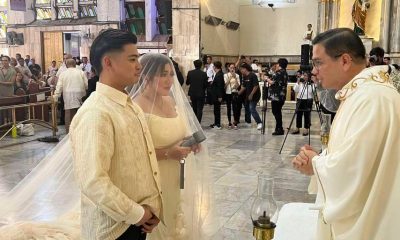Travel
US monuments to Spanish conquest facing mounting criticism

Onate Monument Center, Alcalde, NM Equestrian Statue of Juan De Onate (Photo by A d v a n c e d S o u r c e P r o d u c t i o n s Advanced Source Productions – Flickr: NEW MEXICO San Juan Pueblo DonJuan De Onate/ First Govenor of New Spain, CC BY 2.0)
SANTA FE, N.M. — Public statues and tributes to early Spanish conquerors are facing mounting criticism tied to the brutal treatment of American Indians centuries ago by Spanish soldiers and missionaries, with activists drawing ethical parallels to the national controversy over Confederate monuments.
From California to Florida, historical markers and commonplace names trace the path of the 16th century Spanish conquistadors and missionaries who explored and settled land inhabited by American Indians in what is now the U.S. Few, if any, of the monuments honouring them have come down.
The Spanish presence is particularly noticeable in parts of the Southwest, which Spaniards controlled for about 300 years. In northern New Mexico, statues and annual re-enactments recognize two colonizers who quelled armed uprisings by American Indians and meted out reprisals that included slavery and executions.
On Friday, police arrested at least 12 people in Santa Fe as protesters chanted slogans opposing an annual pageant that marks the return of Spanish conquistador Don Diego de Vargas to New Mexico following a 17th century Indian revolt.
Pageantry supporters say they are honouring their Spanish heritage, paying homage to the Roman Catholic faith and highlighting reconciliation. For Native American tribes, the monuments and events often are reminders of forced religious conversions and violence against resisters of Spanish rule.
Here’s a look at Spanish historical figures whose legacies are stirring protest and debate:
———
DON DIEGO DE VARGAS
Police thronged downtown Santa Fe streets on Friday to contain protests of an annual costumed pageant that re-enacts de Vargas’ 1692 arrival in Santa Fe, some 12 years after Pueblo Indians from small, scattered tribes rebelled against Spain.
There were no signs of violence among the roughly 100 protesters. But police Sgt. Gardner Finney said a dozen people were arrested on charges including trespassing and disorderly conduct.
They included protest organizer Jennifer Marley, a tribal member of San Ildefonso Pueblo and leader of the activist group Red Nation. Led away in hand restraints, she said she hoped images of her arrest would stoke opposition to the re-enactment.
Organizers of the “entrada” — or arrival — of de Vargas say the event on Santa Fe’s downtown plaza portrays a peaceful reconciliation between the conquistador and American Indians in shared reverence for a wood-carved Virgin Mary known as “La Conquistadora.”
New Mexico Deputy State Historian Rob Martinez says the dramatization wrongfully gives the impression that Native Americans welcomed back the Spanish, and activists say it obscures the cruelty de Vargas inflicted as he stamped out resistance to Spanish rule.
Santa Fe schoolchildren have been visited by a dancing troupe portraying Spanish royalty for at least 50 years, led annually by an actor playing de Vargas who wears a shiny, feather-plumed helmet.
School district officials let children skip the presentations this year for the first time in deference to hundreds of students who might feel uncomfortable.
Conchita Lucero of Albuquerque says the Fiesta entrada recognizes perseverance of hardscrabble Spanish settlers.
“It’s a way to honour our ancestors,” she says. “The idea of the entrada is that we came back and we dedicated our lives to the city. … The gates of hell did not open when we came.”
———
JUAN DE ONATE
Juan de Onate’s arrival in present-day New Mexico in 1598 is re-enacted at an annual fiesta in Espanola, a small city set amid several Indian Pueblos in northern New Mexico.
To American Indians, Onate is known for having ordered the right feet cut off 24 captive tribal warriors after his soldiers stormed Acoma Pueblo’s mesa-top “sky city,” an attack precipitated by the killing of Onate’s nephew.
Four hundred years later, in 1998, someone sawed off the foot of an Onate statue at a visitor centre near Espanola named for him.
The former Onate Monument and Visitor Center reopened in August as the Northern Rio Grande National Heritage Center. Board member Patricia Trujillo said some people avoided the building for its focus on Onate, although a statue of him still stands on the path to the front entrance.
Organizers posed questions on public bulletin boards about Onate at the reopening and asked people to respond in writing, but someone crossed out messages that asked to remove the Onate statue and stop the glorification, Trujillo said.
Onate has staying power as a cultural icon, she said.
“When you ask people, it’s kind of a blind patriotism to this pristine moment, the fact he was the first colonizer to come into New Mexico and start this settlement that persisted,” she said. “People find a lot of pride in that.”
Maurus Chino, of Acoma Pueblo, says Onate should no longer be honoured.
“These monuments really mean something obscene and evil to the indigenous people here and all decent people,” he said.
———
JUNIPERO SERRA
A Franciscan friar who founded the Spanish mission system in California, Junipero Serra believed that American Indians needed to be baptized and taught to farm. Once converted, they were prohibited from leaving the missions and became largely dependent on the Spanish, said Robert Senkewicz, a history professor at Santa Clara University.
In August, a statue of Serra in Southern California was splashed with red paint and defaced with the word “murderer” in white. Other Serra statues were vandalized — one beheaded — surrounding his elevation to sainthood two years ago.
The popular picture in colonial California was one of heroic Spanish missionaries and content American Indians, Senkewicz said. Recently, the California school system said children no longer would have to build replica missions in their classrooms.
The problem isn’t Serra himself, Senkewicz said.
“The problem is he’s been allowed to symbolize everything.”
———
JUAN PONCE DE LEON
Juan Ponce de Leon is credited for naming Florida in 1513. Though he did not establish a permanent settlement, statues of him are found throughout the state.
He was among Spanish explorers who forged alliances with American Indians and fought against them. Known for his search for the mythical fountain of youth, Ponce de Leon died from an arrow wound in 1521, said J. Michael Francis, who heads the Department of History and Politics at the University of South Florida, St. Petersburg.
Ponce de Leon and Pedro Menendez de Aviles, who founded St. Augustine in 1565, are less controversial than explorers in the Southwest and the Spanish never gained a stronghold over the peninsula, Francis said.
Protesters say the period of ethnic genocide and environmental degradation is nothing to celebrate.
Chase Iron Eyes, an attorney and activist from the Standing Rock Sioux Tribe, recognized an extinct Florida tribe on the 500th anniversary of Ponce de Leon’s landing.
“If people want to do re-enactments, people want to be proud of their heritage, they want to celebrate these people who are heroes, that’s their right,” he said in an interview Wednesday. “But it’s also a right that the truth be told.”





















